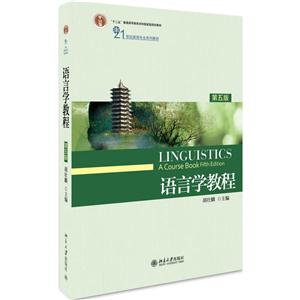CONTENTS
Chapter 1Invitations to Linguistics1.1Why Study Language 1.2What Is Language 1.3Design Features of Language1.3.1Arbitrariness1.3.2Duality1.3.3Creativity1.3.4Displacement1.4Origin of Language1.5Functions of Language1.5.1Informative Function1.5.2Interpersonal Function1.5.3Performative Function1.5.4Emotive Function1.5.5Phatic Communion1.5.6Recreational Function1.5.7Metalingual Function1.6What Is Linguistics 1.7Main Branches of Linguistics1.7.1Phonetics1.7.2Phonology1.7.3Morphology1.7.4Syntax1.7.5Semantics1.7.6Pragmatics1.8Macrolinguistics1.8.1Psycholinguistics1.8.2Sociolinguistics1.8.3Anthropological Linguistics1.8.4Computational Linguistics1.9Important Distinctions in Linguistics1.9.1Descriptive vs. Prescriptive1.9.2Synchronic vs. Diachronic1.9.3Langue & Parole1.9.4Competence & PerformanceChapter 2Speech Sounds2.1Speech Production and Phonetic Transcription2.1.1Speech Production2.1.2Phonetic Transcription—The IPA2.2Consonants and Vowels2.2.1Consonants2.2.2Vowels2.2.3The Sounds of English2.3Phonological Analysis2.3.1Phonemes2.3.2Allophones2.3.3Phonological Rules2.3.4Rule Ordering2.4Suprasegmentals2.4.1Syllable2.4.2Sonority Scale2.4.3Stress2.4.4Intonation and ToneChapter 3Words and Morphology3.1The Nature of Words3.1.1What Is a word 3.1.2Content Words and Function Words3.2Types of Morphemes3.3Morphological Processes3.3.1Derivation3.3.2Compounding3.3.3Inflection3.3.4Minor Morphological ProcessesChapter 4From Word to Text4.1Syntactic Relations4.1.1Positional Relation4.1.2Relation of Substitutability4.1.3Relation of CoOccurrence4.2Grammatical Construction and Its Constituents4.2.1Grammatical Construction4.2.2Immediate Constituents4.2.3Endocentric and Exocentric Constructions4.2.4Coordination and Subordination4.3Syntactic Function4.3.1Subject4.3.2Predicate4.3.3Object4.3.4The Relation between Classes and
Functions4.4Category4.4.1Number4.4.2Gender4.4.3Case4.4.4Agreement4.5Phrase, Clause and Sentence4.5.1Phrase4.5.2Clause4.5.3Sentence4.6Recursiveness4.6.1Conjoining4.6.2Embedding4.7Beyond the Sentence4.7.1Sentential Connection4.7.2Cohesion4.7.3CoherenceChapter 5Meaning5.1Meanings of “Meaning”5.2The Referential Theory5.3Sense Relations5.3.1Synonymy5.3.2Antonymy5.3.3Hyponymy5.4Componential Analysis5.5Sentence Meaning5.5.1Cognitive Semantics5.5.2Logical SemanticsChapter 6Language and Cognition6.1What Is Cognition 6.2Three Approaches to Language and
Cognition6.3What Is Psycholinguistics 6.4Language Acquisition6.4.1Holophrastic Stage6.4.2TwoWord Stage6.4.3Stage of ThreeWord Utterances6.4.4Fluent Grammatical Conversation Stage6.5Language Comprehension6.5.1Word Recognition 6.5.2Comprehension of Sentences 6.5.3Comprehension of Text 6.6Language Production6.6.1Access to Words 6.6.2Generation of Sentences 6.6.3Written Language Production 6.7What Is Cognitive Linguistics 6.8Construal and Construal Operations6.8.1Attention/Salience6.8.2Judgment/Comparison6.8.3Perspective/Situatedness6.9Categorization6.9.1Basic level6.9.2Superordinate level6.9.3Subordinate level6.10Image Schemas6.11Metaphor6.11.1Structural Metaphors6.11.2Orientational Metaphors6.11.3Ontological Metaphors6.12Metonymy6.12.1Whole ICM and Its Part(s)6.12.2Parts of an ICM6.13Blending TheoryChapter 7Language, Culture, and Society7.1Language and Culture7.1.1How Does Language Relate to
Culture 7.1.2More about the SapirWhorf
Hypothesis7.1.3Case Studies7.1.4To What Extent Do We Need Culture
in Our Linguistic Study 7.1.5Culture in Language Teaching
Classroom7.2Language and Society7.2.1How Does Language Relate to
Society 7.2.2A Situationally and Socially Variationist
Perspective7.2.3What Should We Know More about
Sociolinguistics 7.2.4What Implications Can We Get from
Sociolinguistics 7.3CrossCultural Communication7.3.1What Should We Know All about
CrossCultural Communication 7.3.2Case Studies7.4SummaryChapter 8Language in Use8.1Speech Act Theory8.1.1Performatives and Constatives8.1.2A Theory of the Illocutionary Act8.2The Theory of Conversational Implicature8.2.1The Cooperative Principle8.2.2Violation of the Maxims8.2.3Characteristics of Implicature8.3PostGricean Developments8.3.1Relevance Theory8.3.2The Q and Rprinciples8.3.3The Q, I and Mprinciples8.3.4A SocioCognitive ApproachChapter 9Language and Literature9.1Introduction9.2Some General Features of the Literary
Language9.2.1Foregrounding and the Grammatical
Form9.2.2Literal Language and Figurative
Language9.2.3The Analysis of Literary Language9.3The Language in Poetry9.3.1Sound Patterning9.3.2Different Forms of Sound Patterning9.3.3Stress and Metrical Patterning9.3.4Conventional Forms of Metre and
Sound9.3.5The Poetic Functions of Sound and
Metre9.3.6How to Analyse Poetry 9.4The Language in Fiction9.4.1Fictional Prose and Point of View9.4.2Speech and Thought Presentation9.4.3Prose Style9.4.4How to Analyse the Language of
Fiction 9.5The Language in Drama9.5.1How Should We Analyse Drama 9.5.2Analysing Dramatic Language9.5.3How to Analyse Dramatic Texts 9.6The Cognitive Approach to Literature9.6.1Theoretical Background9.6.2An Example of Cognitive AnalysisChapter 10Language and Computer10.1Introduction 10.2ComputerAssisted Instruction(CAI)10.2.1CAI, CAL, CALL10.2.2CALL Development and Technology10.2.3MOOC10.3Machine Translation10.3.1History of Development10.3.2Research Methods10.3.3MT and the Internet10.3.4Speech Translation10.3.5MT and Human Translation10.3.6MT Quality10.4Corpus Linguistics10.4.1Definition10.4.2Criticisms and the Revival of Corpus
Linguistics10.4.3Concordance10.4.4Text Encoding and Annotation10.4.5The Roles of Corpus Data10.5Computer Mediated Communication10.5.1Mail and News10.5.2PowerPoint 10.5.3Blog10.5.4Chatroom, Facebook, WeChat 10.5.5Emoticons and SmileysChapter 11Second and Foreign Language Teaching11.1Introduction11.2Language Learning11.2.1Grammar in Language Learning11.2.2Input in Language Learning11.2.3Interlanguage in Language Learning11.3Language Teaching11.3.1The DiscourseBased View of Language
Teaching11.3.2The Universal Grammar and Language
Teaching11.4Syllabus Design11.4.1A Clarification of Terms: Syllabus and
Curriculum 11.4.2Theoretical Views Behind Syllabus
Design11.4.3Types of Syllabus11.4.4Current Trends in Syllabus Design11.5Contrastive Analysis and Error Analysis11.5.1Contrastive Analysis (CA)11.5.2Error Analysis (EA)11.6The Use of Corpus in Language Teaching11.6.1Types of Corpora11.6.2The Uses of Corpora11.7Foreign Language Education Policy11.8SummaryChapter 12Theories and Schools of Modern Linguistics12.1Introduction12.2The Prague School12.2.1Introduction12.2.2Phonology and Phonological
Oppositions12.2.3Functional Sentence Perspective (FSP)12.3The London School12.3.1Malinowski's Theories12.3.2Firth's Theories12.3.3Halliday and SystemicFunctional
Grammar12.3.4Appliable Linguistics12.4American Structuralism12.4.1Early Period: Boas and Sapir12.4.2Bloomfield's Theory12.4.3PostBloomfieldian Linguistics12.5TransformationalGenerative Grammar12.5.1The Innateness Hypothesis12.5.2What Is a Generative Grammar 12.5.3The Classical Theory12.5.4The Standard Theory12.5.5The Extended Standard Theory12.5.6The Government and Binding Theory12.5.7The Minimalist Program and After12.5.8Chomsky's Fundamental Contribution12.6Revisionists or Rebels?12.6.1Case Grammar12.6.2Generative SemanticsBibliographyGlossary and Index















